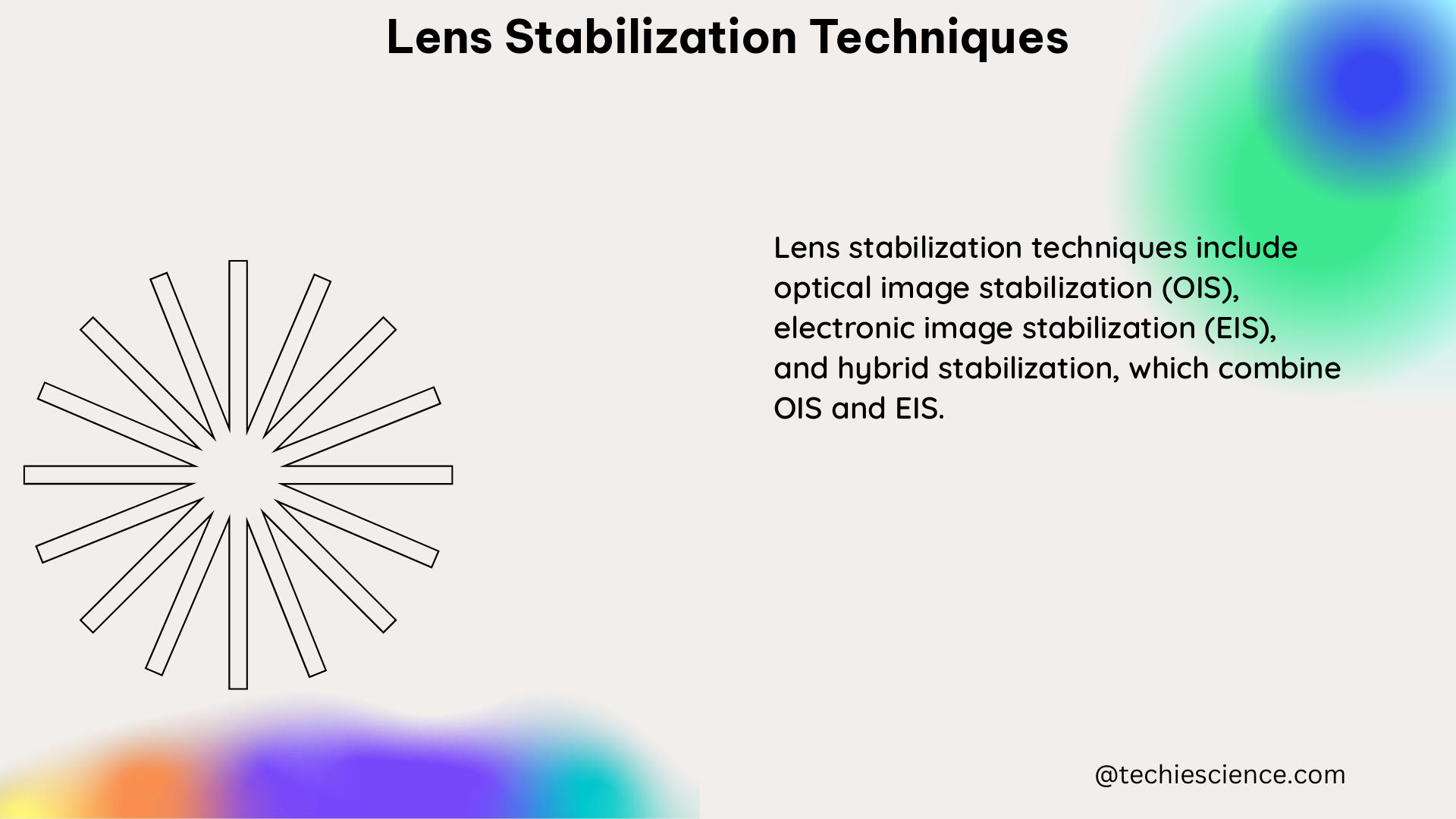Lens stabilization techniques are crucial in modern photography and videography to reduce image blur caused by small movements of the camera. Understanding the underlying physics and practical implementation of these techniques is essential for physics students interested in optics and imaging systems.
Types of Lens Stabilization Techniques
There are two main types of lens stabilization techniques: lens-based and sensor-shift.
Lens-based Stabilization
Lens-based stabilization involves the use of gyroscopic sensors, also known as angular rate sensors or gyrosensors, to detect camera movement. These sensors measure the angular rate of the camera’s movement in both the vertical and horizontal directions. The lens elements are then adjusted accordingly to counteract the detected camera shake.
The formula for calculating the angular rate of a camera is:
ω = α/t
Where:
– ω is the angular rate (in degrees/second)
– α is the angular displacement (in degrees)
– t is the time interval (in seconds)
For example, if a camera moves 10 degrees in 0.1 seconds, the angular rate would be:
ω = 10 degrees / 0.1 seconds = 100 degrees/second
Sensor-shift Stabilization
Sensor-shift stabilization, on the other hand, moves the image sensor to counteract camera shake. This is achieved by using actuators that physically shift the sensor in the opposite direction of the detected camera movement. The advantage of sensor-shift stabilization is that it can be applied to any lens, as the stabilization is performed at the sensor level rather than within the lens itself.
Evaluating Lens Stabilization Effectiveness

To evaluate the effectiveness of lens stabilization techniques, several factors must be considered, including the amount of shake reduction, the type of movement being corrected, and the speed of correction.
One way to quantify the performance of lens stabilization is to measure the reduction in blur caused by camera shake. This can be done using objective, quantitative measurements of blur, as described in the paper “Image Stabilization Testing at The Imaging Resource”.
The paper outlines a methodology for testing image stabilization systems, which involves measuring the blur in images taken with and without stabilization. The results are then analyzed using statistical methods to determine the effectiveness of the stabilization system. The authors note that single-shot comparisons of IS systems are not meaningful, as the variation from shot to shot can often be greater than the average variation with IS on vs IS off. Instead, they recommend using statistical methods to analyze a set number of shots to accurately measure IS performance.
Physics Principles Behind Lens Stabilization
The physics behind lens stabilization techniques can be explained using the concept of angular rate sensors, or gyrosensors. These sensors detect how quickly the camera is moving in both vertical and horizontal directions. This information is then used to adjust the lens elements or the image sensor to counteract camera shake.
Gyrosensor Operation
Gyrosensors work on the principle of the conservation of angular momentum. When a camera is subjected to angular displacement, the gyrosensor detects this change and generates a corresponding electrical signal. This signal is then used to control the actuators that move the lens elements or the image sensor to compensate for the detected movement.
The formula for calculating the angular rate of a camera, as mentioned earlier, is:
ω = α/t
Where:
– ω is the angular rate (in degrees/second)
– α is the angular displacement (in degrees)
– t is the time interval (in seconds)
Physics Examples
Consider a camera mounted on a moving vehicle. Without lens stabilization, the images captured would be blurry due to the movement of the vehicle. However, with lens stabilization, the lens elements or the image sensor are adjusted to counteract the movement of the vehicle, resulting in clearer images.
Physics Numerical Problems
Numerical problems involving lens stabilization can be used to reinforce the understanding of the underlying physics principles. For example:
- If a camera moves 10 degrees in 0.1 seconds, what is the angular rate of the camera?
- ω = α/t
- ω = 10 degrees / 0.1 seconds
-
ω = 100 degrees/second
-
A camera has a maximum angular displacement of 5 degrees and a maximum angular rate of 50 degrees/second. What is the minimum time interval required for the camera to reach its maximum angular displacement?
- ω = α/t
- t = α/ω
- t = 5 degrees / 50 degrees/second
- t = 0.1 seconds
These types of numerical problems can help students understand the relationship between angular displacement, angular rate, and time, which is crucial for designing and evaluating lens stabilization systems.
Conclusion
Lens stabilization techniques are an essential tool in modern photography and videography. By understanding the underlying physics principles, including the use of gyrosensors and the formula for calculating angular rate, physics students can gain a deeper understanding of how these systems work and how to evaluate their effectiveness. The combination of theoretical knowledge and practical examples provided in this guide should equip students with the necessary skills to master lens stabilization techniques.
References
- Image Stabilization Testing at The Imaging Resource: Link
- Optical image stabilization for digital cameras – ResearchGate: Link
- Limits to image stabilization techniques. – Digital Photography Review: Link
- A Comparision of Three Methods to Increase Scleral Contact Lens On-eye Stability: Link
- A Survey of Practical Design Considerations of Optical Imaging Stabilization Systems for Small Unmanned Aerial Systems: Link

The lambdageeks.com Core SME Team is a group of experienced subject matter experts from diverse scientific and technical fields including Physics, Chemistry, Technology,Electronics & Electrical Engineering, Automotive, Mechanical Engineering. Our team collaborates to create high-quality, well-researched articles on a wide range of science and technology topics for the lambdageeks.com website.
All Our Senior SME are having more than 7 Years of experience in the respective fields . They are either Working Industry Professionals or assocaited With different Universities. Refer Our Authors Page to get to know About our Core SMEs.